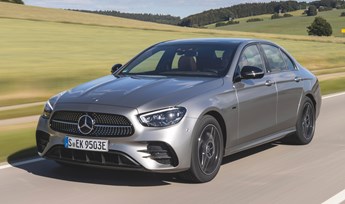
The start point for the best source of fleet information |
First drive: Mercedes-Benz E-Class
Date: 02 September 2020 | Author: Illya Verpraet

|
|
||||||||||||||||||||
When we drove the outgoing Mercedes-Benz E 300e a few months ago, we remarked that even though it had been on the market for four years, it still felt fresh.
Mercedes must have felt the same, because the changes for the facelift aren't momentous. There are redesigned bumpers with slimmer, more aggressive-looking headlights, which are full-LED, regardless of equipment grade. Mercedes has added a few new interior upholstery options, as well as a new steering wheel that is better at detecting if the driver is still paying attention when using adaptive cruise control.
The biggest changes are with the suitably comprehensive engine line-up, which comprises two four-cylinder petrol engines and one six-cylinder; three four-cylinder diesels and one
six-cylinder; and both a petrol and a diesel plug-in hybrid.
The availability of a diesel hybrid is still unique to Mercedes, offering the potential of electric running in the city and diesel economy on longer runs. Like the six-cylinders, all of the petrol
four-cylinders now get mild hybrid assistance, while on the diesel side, it is only the E 300d that gets the 48V mild hybrid system to assist its already powerful two-litre, twin-turbo diesel.
At the launch event, we got to try the E 300d and the E 300e hybrid. Unfortunately, while the plug-in hybrid will be the more fleet-friendly choice thanks to its 10% BIK band, it is the conventional diesel that is the more pleasant car to drive.
With its 280hp, it is plenty fast of course - the lower-powered E 220d will be ample for most people - but the way the diesel engine and the mild hybrid assistance interact is impressively seamless, and the coasting function, which switches off the engine when slowing down to a stop, works well too.
The plug-in hybrids offer low company car tax thanks to the ability to drive in electric mode for 35 miles. EV mode itself is very serene and allows for enough power to drive swiftly without the engine cutting in.
However, because the current generation of E-Class wasn't originally conceived with a plug-in hybrid in mind, the battery pack robs a lot of boot space. The hump in the boot floor this creates is like permanently transporting a box of flat-pack furniture.
The complex powertrain in the E 300e also introduces some jerkiness around town as the software shuffles between electric and petrol power.
Although it is not a fundamental issue, it is rather unbefitting of a car of this calibre (and price tag). That is unfortunate, because the rest of the E-Class sublimely marries modern technology with old-school luxury. Gone is the analogue gauge cluster, or even the smaller 10.3in screens, as all facelifted E-Classes in the UK get twin 12.3in screens.
The amount of configurability can be baffling at first and you would need more time than we got at the launch to truly get to the bottom of the system's capabilities, but it is a credit to how logically it is structured that it is possible to get to grips with the most important functions in a matter of hours.
You can control the infotainment system in four different ways: the touchscreen, the touch pad on the centre console, the steering wheel controls, or using voice activation. Depending on whether you are driving or stationary, at least one should be convenient.
Having said that, the voice control, initiated by saying "hey Mercedes", didn't seem particularly keen on understanding my commands. Using it also stops Apple Carplay, which is quite annoying. Inevitably with a system like this, there are a handful of other usability issues, but nothing too grating. The wood trim, leather upholstery and multi-adjustable massage seats are exquisite, but then some are very expensive options. The ride, meanwhile, is very refined on the (again, optional) air suspension, even with huge 20in alloy wheels. Those large wheels are one option that is better avoided, however, as the car we drove on smaller wheels let considerably less road noise filter into the interior.
The Mercedes-Benz E-Class remains a benchmark in the large executive saloon and estate market, with peerless comfort, up-to-date tech, and a wide range of frugal engines, including the only plug-in hybrid diesel on sale. It is a pity the hybrid system isn't better integrated, but then it is a bit cheaper than a comparable BMW 530e.
Mercedes-Benz E 300e AMG Line Edition
P11D: £46,175
Residual value: TBC
Depreciation: TBC
Fuel: TBC
Service, maintenance and repair: TBC
Cost per mile: TBC
Fuel consumption: 166.2 mpg
CO2 (BIK band): 37g/km (10%)
BIK 20/40% a month: TBC
Boot space: 370 litres
Engine size/power: 1,991cc/320hp petrol and electric combined
Verdict |
8/10 |
|||
 |
|
 |
|
|










